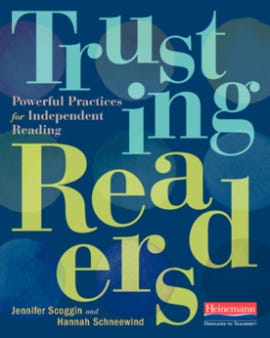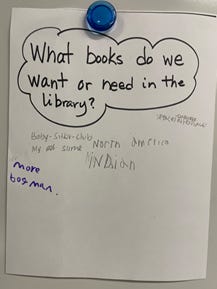Our job is to understand what our students find engaging and to create the conditions for engagement in our classrooms.
Jennifer Scoggin and Hannah Schneewind, Trusting Readers: Powerful Practices for Independent Reading
Our new reading unit in 3rd grade began this week as we returned from Spring Break. Embedded within this unit which focuses on how we make meaning while reading nonfiction texts are our efforts to grow ourselves as independent readers. Some of the notes-to-self as my colleagues and I began the unit include ensuring our classroom library has new books that not only fit our science and social studies topics but also reflect our students’ interests.
“The ideal classroom library is organized to inspire readers, is accessible, and encourages students to use it independently,” says authors Jennifer Scoggin and Hannah Schneewind in Trusting Readers: Powerful Practices for Independent Reading. Regie Routman, in The Heart-Centered Teacher: Restoring Hope, Joy, and Possibility in Uncertain Times, shares that libraries are the first opportunities for many students to “glimpse what might be possible” and to see “who they might become in their present and future lives.”
For these educators, libraries are not mere collections of books. They reflect the lives and identities of each of the students who come to us, who trust us to teach with their best interests in mind. Jen, Hannah, and Regie encourage us to keep the library “vibrant” throughout the year, meaning it constantly evolves to reflect the possibilities of the readers it serves. As Regie concludes, “Anything less does a disservice to our readers.”
Into the Classroom
During our Spring Break, I spent some time in my local libraries, collecting nonfiction and fiction books to refresh the classroom library that is available to the students. I relied on a list of topics, genres, and series the students had shared they wanted in the library. The first two days back from the break, the students spent time investigating the new titles I’d collected, considering which books they might want explore further: fiction, nonfiction, and of course, poetry.
When I first shared the newest books I’d checked out from the public library for the classroom, the books on Minecraft generated powerful buzz. But the joy quickly turned to concern as students realized the Minecraft tub contained only 8 books (which was every book my local library branch had available) and many students in the class would want them for their book collections. But, Ms. Debra, what if the first people getting their books take them all? The students quickly recognized the need for a system to share these precious but limited-in-number texts in an equitable way. I remained quiet, trusting the students to come up with solutions.
First, one student suggested that only one partnership have all the books for a time and then the books could be rotated after that group finished reading them. After a moment’s consideration, the students quickly realized that this solution meant it could be quite a while before their opportunity to have the Minecraft books came around. Valentina then offered an alternative plan, “What if only one person in the partnership gets a Minecraft book and they share it with their partners, rather than everyone in the partnership getting them all? Then we could all have some to read.” Lots of nodding followed her reasonable suggestion. The class agreed to try Valentina’s idea to see if it would work, with the caveat that we will revisit this problem if her solution doesn’t work.
Midweek, as the students began to create their new independent reading book collections, empty tubs in our library revealed their passions—dogs, cooking for kids, Minecraft, and, of course, Dogman (because, really, can any classroom ever have enough Dogman books!). These in-demand books also led to an unexpected moment of generosity.
Can we get….? and Can we get more…? questions began to permeate the classroom. To capture this thinking, I posted a sheet for students to record what they wanted or felt we needed in our library. On the first day, Baby-Sitters Club, My Pet Slime, and more Dogman led the fiction choices, with Space, Astronauts, and the DK book of North American Indians holding the top places for nonfiction reading topics.
Later in the week, one student, David, decided not to wait for me to take care of the pressing need for more Dogman books. He had his own solution to the problem.
“Can I bring my Dogman books and put them in the library for the kids to read?” he quietly asked one morning before school.
I swallowed the lump that appeared in my throat at his kind gesture. “Are you sure you want to share your books with the class?” I asked.
“Yes, I’ve already read them. I could put them in the library and the kids could read them with their partners,” he said with a big smile.
Of course I agreed to David generously lending his personal books to the class, contingent on his parents agreeing, which they did, and so David returned the following day with four of his own Dogman books to loan to the classroom library. We began our morning meeting with David telling the students about his decision to share his books; the other students were super excited to have more copies of this beloved series and quickly stated their commitment to be especially careful with the books because they were David’s own books. Later, I overheard another student, Cristian, sharing with his partners that the Dogman in his possession was David’s. As he proudly showed them David’s name on the inside front cover, Cristian added he would be sure to be “extra careful cause it’s David’s book.”
Libraries are about so much more than just books.
Teacher decisions that affect the Conditions of Learning
· Creating a dynamic classroom library. A learning environment which puts the classroom library in a central role provides the kind of immersion necessary for students to learn. Some people might think of this as “incidental learning,” but “incidental is a poor word choice because it trivializes the process” (Crouch and Cambourne, 2020). The classroom library offers readers choice in what they read, considering their interests at this point in their reading journey. My role as their teacher is to make those choices possible.
· Having students problem-solve for themselves. These readers take responsibility for their reading lives. They make their preferences known and are willing to ask for what they are interested in. They raise issues that concern them and then take responsibility for solving those issues, listening to the considerations of others and finding ways to share. Living in this community of learners contributes to the engagement of all the readers in the class.
· Making space for kind gestures by students. David’s generosity in sharing his own books with his fellow readers finds a place to shine when the community of learners—teachers and students—values and appreciates his gift to them. His expectation that they will do so strengthens his engagement and trust in the learning process.
Try this out
Use these questions to talk with your colleagues about the role of classroom libraries in the reading lives of students.
· How do you make the classroom library a central part of learning?
· How do you keep the classroom library “vibrant” for your learners?
· How do you ensure the library reflects the interests of the students in your classroom?
· How do you provide time and opportunity for your students to communicate and problem-solve with you and the class regarding the classroom library?




Debra, thanks for this powerful article. I love your line, "Libraries are about so much more than just books." You make that abundantly clear in the engaging story you tell--about meeting the needs and interests of your third graders through ensuring students can choose and access the books they want to read. The creative solutions the students come up with show what's possible when we trust and support learners and give them agency to find and read the diverse, engaging books they seek. Well done!
We are honored that you are able to put parts of our book into practice in your classroom. You make the library work deeper by bringing in the Conditions of Learning. We can't wait to hear what the students do next with their books!